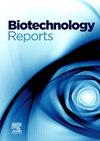Biogenic copper and copper oxide nanoparticles to combat multidrug-resistant Staphylococcus aureus: Green synthesis, mechanisms, resistance, and future perspectives
Q1 Immunology and Microbiology
引用次数: 0
Abstract
Antimicrobial resistance has increased alarmingly in recent years, with the World Health Organization identifying multidrug-resistant Staphylococcus aureus as a particular threat to global public health due to its extensive resistance profile and associated high mortality rates. While various metal nanoparticles have been explored as antimicrobial agents, the specific advantages of biosynthesized copper nanoparticles against MDR S. aureus remain inadequately consolidated in the literature.
Objective
This review uniquely evaluates the emerging evidence for biosynthesized copper nanoparticles as a sustainable, cost-effective, and potentially alternative to conventional antibiotics against multidrug-resistant S. aureus strains.
Methods
We systematically analyzed current literature on green synthesis methods for copper and copper oxide nanoparticles, their characterization techniques, antimicrobial mechanisms, and efficacy against multidrug-resistant S. aureus, focusing on identifying knowledge gaps and future research directions.
Results
Unlike other metal nanoparticles, biosynthesized copper nanoparticles demonstrate significant antibacterial activity against multidrug-resistant S. aureus through multiple simultaneous mechanisms that bacteria try to develop resistance against. Their unique physicochemical properties enable enhanced bacterial elimination compared to conventional antibiotics and other metal nanoparticles, with minimal toxicity to mammalian cells at therapeutic concentrations. Our analysis further reveals the considerable potential of these nanoparticles to overcome existing biological barriers in infection sites that limit conventional therapies.
Conclusion
This broad assessment of biosynthesized copper nanoparticles shows strong potential as a therapy against MDR S. aureus and provides a foundation for future research to address antimicrobial resistance where current treatments fail.
生物源铜和氧化铜纳米颗粒对抗多重耐药金黄色葡萄球菌:绿色合成、机制、耐药性和未来展望
近年来,抗菌素耐药性的增加令人震惊,世界卫生组织将耐多药金黄色葡萄球菌确定为对全球公共卫生的特殊威胁,因为它具有广泛的耐药特征和相关的高死亡率。虽然各种金属纳米颗粒已经被探索作为抗菌剂,但生物合成铜纳米颗粒对抗耐多药金黄色葡萄球菌的具体优势在文献中仍然没有得到充分的巩固。目的:本综述独特地评价了生物合成铜纳米颗粒作为一种可持续的、具有成本效益的、潜在的替代传统抗生素治疗耐多药金黄色葡萄球菌菌株的新证据。方法系统分析了铜和氧化铜纳米颗粒的绿色合成方法、表征技术、抗菌机制以及对耐多药金黄色葡萄球菌的抗菌效果等方面的文献,重点找出了知识空白和未来的研究方向。结果与其他金属纳米颗粒一样,生物合成的铜纳米颗粒通过多种机制对多重耐药金黄色葡萄球菌显示出显著的抗菌活性。与传统抗生素和其他金属纳米颗粒相比,其独特的物理化学特性增强了细菌的清除能力,在治疗浓度下对哺乳动物细胞的毒性最小。我们的分析进一步揭示了这些纳米颗粒在克服感染部位现有的限制传统治疗的生物屏障方面的巨大潜力。结论对生物合成铜纳米颗粒的广泛评估显示其作为耐多药金黄色葡萄球菌治疗的强大潜力,并为未来研究解决当前治疗失败的抗菌药物耐药性提供了基础。
本文章由计算机程序翻译,如有差异,请以英文原文为准。
求助全文
约1分钟内获得全文
求助全文
来源期刊

Biotechnology Reports
Immunology and Microbiology-Applied Microbiology and Biotechnology
CiteScore
15.80
自引率
0.00%
发文量
79
审稿时长
55 days
期刊介绍:
Biotechnology Reports covers all aspects of Biotechnology particularly those reports that are useful and informative and that will be of value to other researchers in related fields. Biotechnology Reports loves ground breaking science, but will also accept good science that can be of use to the biotechnology community. The journal maintains a high quality peer review where submissions are considered on the basis of scientific validity and technical quality. Acceptable paper types are research articles (short or full communications), methods, mini-reviews, and commentaries in the following areas: Healthcare and pharmaceutical biotechnology Agricultural and food biotechnology Environmental biotechnology Molecular biology, cell and tissue engineering and synthetic biology Industrial biotechnology, biofuels and bioenergy Nanobiotechnology Bioinformatics & systems biology New processes and products in biotechnology, bioprocess engineering.
 求助内容:
求助内容: 应助结果提醒方式:
应助结果提醒方式:


